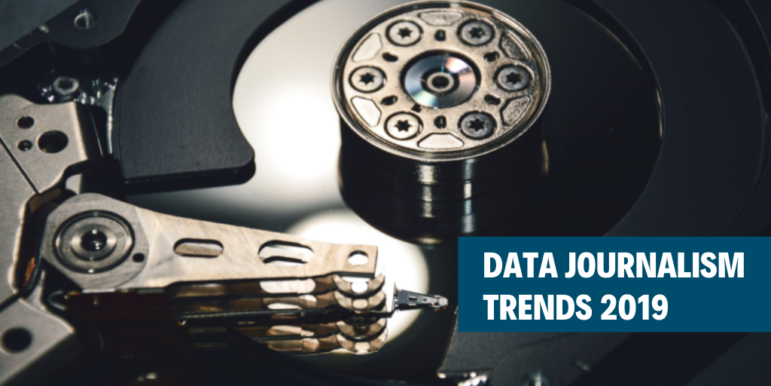With the global spread of data journalism, the advent of artificial intelligence, and growing use of big data amid a blizzard of disinformation, GIJN asked experts around the world what they anticipate for 2019. Here are their thoughts on the major trends, ideas and technologies that will affect how we do our jobs.
Helena Bengtsson (Sweden)
Data Editor, Sveriges Television
 We will discover new ways to use machine learning and artificial intelligence for gathering and analyzing data. My hope is that we will be able to analyze unstructured data and documents from many different formats, and become better at extracting names, places, dates and other entities.
We will discover new ways to use machine learning and artificial intelligence for gathering and analyzing data. My hope is that we will be able to analyze unstructured data and documents from many different formats, and become better at extracting names, places, dates and other entities.
We’ll also use more data generated by the public — analyzing social media or using crowdsourcing for our projects. Journalists have to start listening more, and that is also true for the field of data journalism.
Considering the political climate in the US and Europe, I fear that our access to information and data will become more limited and it might be harder to get the answers we seek from politicians and government authorities.
Alberto Cairo (US)
Knight Chair in Visual Journalism, University of Miami
 The older I get, the less interested I become in new flashy technologies and the more worried I get about getting the fundamentals right. One of the unsolved problems in journalism is how to depict and explain statistical confidence and uncertainty in a way that (a) shows people that numbers are always imprecise, and (b) that even if that’s the case, they are often the best or only evidence we have, so we need to rely on them anyway.
The older I get, the less interested I become in new flashy technologies and the more worried I get about getting the fundamentals right. One of the unsolved problems in journalism is how to depict and explain statistical confidence and uncertainty in a way that (a) shows people that numbers are always imprecise, and (b) that even if that’s the case, they are often the best or only evidence we have, so we need to rely on them anyway.
This two-fold problem will keep challenging us for years, if not decades. The public —and, by extension, many journalists— believe that numbers are precise, accurate and objective representations of reality, and develop a blind faith in them. When numbers fail, as they often do, the public and those same journalists become disillusioned and reject numbers outright as they realize that their high expectations were unfounded. We need to fight against this black-and-white view.
Pinar Dag (Turkey)
Co-founder, Veri Gazeteciliği Türkiye (Data Journalism Turkey)
 The most major trends will be focused on technology, visual design, innovation and coding for doing better data journalism.
The most major trends will be focused on technology, visual design, innovation and coding for doing better data journalism.
This year’s big data will continue to be more versatile and will help further the visibility of local problems, attracting global attention. More focus will be placed on data inequality. And the number of countries that open their data will increase, with more work being carried out in support of access to data for data reporting.
With more fake news in store in 2019, fact check-based data reporting which validates data — and shows methods and data sets — will be increasingly important.
While there are a lot of data journalism tools out there already, the tools that journalists develop for journalists will gain more importance because they know what kind of problems we encounter.
Marina Walker Guevara (US)
Deputy Director, International Consortium of Investigative Journalists (and soon-to-be Executive Editor, Pulitzer Center on Crisis Reporting)
Data has played a huge role in some of the most powerful and consequential reporting we have seen in recent years. But a lack of smart, long-term planning around that data has led some newsrooms to waste time, money and possibly miss stories that would only have emerged if we connected, integrated and made searchable the terabytes of databases and documents that live in isolation in reporters’ computers and desks, often unused after a story ran.
Fortunately, this is starting to change! Watch out for the stories that will come out of newsrooms that are ‘networking’ and breathing new life on the data their reporters have collected for years or decades. Once a knowledge hub like this is in place, machine learning can take over the more time-consuming and repetitive tasks and help reporters find unforeseen relationships, patterns and scoops.
Brant Houston (US)
Knight Chair in Investigative and Enterprise Reporting, University of Illinois at Urbana-Champaign, and Board Chair, Global Investigative Journalism Network
 This year we will see a greater exploration of the possibilities of artificial intelligence, whether it is helping unmask false reports and propaganda, making some news gathering more routine and efficient (especially from social media) or developing more sophisticated methods with which a journalist can use AI with a fuller understanding of its limitations.
This year we will see a greater exploration of the possibilities of artificial intelligence, whether it is helping unmask false reports and propaganda, making some news gathering more routine and efficient (especially from social media) or developing more sophisticated methods with which a journalist can use AI with a fuller understanding of its limitations.
I also foresee that journalists will more often begin their data analysis with visualizations since that is often an easier way to initially identify patterns and outliers. In addition, journalists will continue to construct better ways of visual storytelling when reporting on the complex transactions and networks involved in global corruption.
Jennifer LaFleur (US)
Data Editor, Investigative Reporting Workshop, American University
 While I don’t think 2019 will bring us jet packs to zip to reporting assignments, technology will continue to be a powerful tool for investigative reporting. None of this is new, but these tools are becoming more accessible, user friendly and will likely be used more widely.
While I don’t think 2019 will bring us jet packs to zip to reporting assignments, technology will continue to be a powerful tool for investigative reporting. None of this is new, but these tools are becoming more accessible, user friendly and will likely be used more widely.
Artificial intelligence and machine learning have helped newsrooms more efficiently process huge document dumps, identify doctored photos and videos, and draw connections between people and organizations.
Data from satellites, known as remote sensing, has become a valuable tool to report on sea rise, deforestation and wildfires. But many more possible applications exist — particularly in places where data about what is happening on the ground (literally) is not available. Look for more tools to make this data even more accessible.
But beware of shiny objects. We must avoid getting distracted by the technology itself, but rather, use it to expose truths and hold the powerful accountable. We also need to continue to collaborate and take advantage of technology that fosters collaboration.
Yolanda Ma (China)
Award-Winning Digital Strategist
 The world is becoming more interconnected with complex issues, many of which require international investigations, such as illicit financial flows, wildlife smuggling, refugee resettlement, etc. As Simon Rogers pointed out in his prediction for Nieman Lab, data journalism “will become a truly global field of work” this year, and there will be more cross-border collaborations, globally and regionally.
The world is becoming more interconnected with complex issues, many of which require international investigations, such as illicit financial flows, wildlife smuggling, refugee resettlement, etc. As Simon Rogers pointed out in his prediction for Nieman Lab, data journalism “will become a truly global field of work” this year, and there will be more cross-border collaborations, globally and regionally.
While more media outlets are equipped with the data skills, not many are able to afford foreign correspondents, nor do they have the insights and networks overseas, especially when there are language barriers. Institutions and networks like ICIJ and GIJN have been facilitating such collaborations, but we might see more efforts that are organically initiated by certain media organizations or even independent journalists, as far as they share the same value towards data and have the same level of understanding of tools available.
Paul Radu (Romania)
Executive Director, Organized Crime and Corruption Reporting Project
 This year will bring more of a symbiotic relationship between coders and investigative reporters, especially where the reporting can be ignited from pattern recognition algorithms.
This year will bring more of a symbiotic relationship between coders and investigative reporters, especially where the reporting can be ignited from pattern recognition algorithms.
It’s all about putting more science behind how journalists pick their stories so that the public is served properly and the reporting is less connected to the journalists’ ego. Coders will increasingly discover that journalists can provide the necessary story context, and reporters will realize that coding adds a lot more depth and long term value to investigative reporting and to journalism as a public service. At the same time, newsroom integration between programmers and journalists will grow with some of the most traditional media operations.
Journalists are beginning to discover that, when covering global issues, it is not satisfying to work with just open data that is generated at the nation/state level. Both the quantity and quality of such data are very poor, especially when its sources and analysis are distorted and influenced by internal politics and ideological takes. Journalism and other industries dependent on massive open data will gradually turn towards generating their own data through direct input, using all types of commercially available sensors and other means.
Experts’ comments were compiled by GIJN Program Coordinator Eunice Au.
Ready to up your investigative journalism game with the latest in tips, tools and techniques? Check out GIJN’s Resource Center with information in eight languages: Arabic, Bangla, Chinese, English, French, Portuguese, Russian and Spanish. Don’t miss our expanded guide to the latest data journalism resources.

